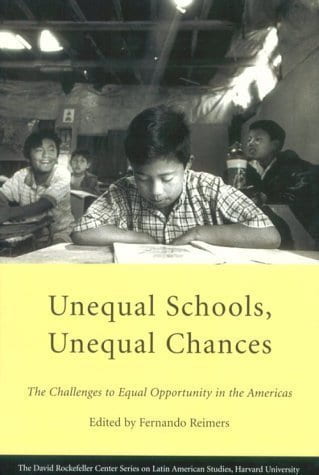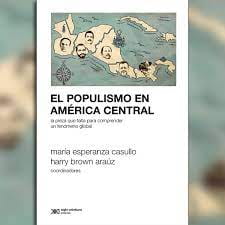A Review of Unequal Schools, Unequal Chances
The Challenges to Equal Opportunity in the Americas

Unequal Schools, Unequal Chances by FERNANDO REIMERS
Can education lead to social and economic equity? Think of your own educational experience, your current position in social and economic spheres and how you got there. Do you have substantive amounts of education? Do you come from privilege? Or are you simply an anomaly, one out of millions that somehow seeped through the cracks of poverty, and made it up the social ladder? Perhaps you don’t fit into either of these categories, and luckily had access to all levels of high-quality education, regardless of your economic and/or social status as a child. Curious?
Fernando Reimers, in Unequal Schools, Unequal Chances has crafted a masterpiece that probes the themes discussed above. As sole editor, he gathered renowned scholars from Latin America and beyond at a series of workshops at Harvard to examine the question: “Is it possible to attain equality of educational opportunity in highly unequal societies?” As the primary source of analysis, Latin America represents a system with the highest income inequality in the world, making it the quintessential host for examining the link between poverty and education. The text clearly discusses and emphasizes the effects of poverty on access and quality of education. At the same time, it exposes varying forms of education reform efforts conceived through policy to “compensate” for the perceived deficiencies enacted by poverty. Most education reform is from the top-down in Latin America, perhaps with the exception of Colombia’s “La Escuela Nueva,” created by the local community as a model of education reform.
From Argentina, Chile, Peru, Colombia, Mexico, the Caribbean and the United States, each contributing author reflects on the role of poverty in education and what education policy has done to alleviate such factors with the end goal of increasing educational attainment and achievement for the most disenfranchised. Some probe into the political systems of their respective countries as they connect to the wider education policy framework; others focus on action what policy has been enacted, for whom, how, where, and with what consequences. A commentary following each chapter prompts the reader to analyze further and confirms or challenges one’s own thoughts.
Chapter subjects range from “Education and Indian Peoples in Mexico: An Example of Policy Failure” by Sylvia Schmelkes to “Policy and Equity: Lessons of a Third of a Century of Educational Reforms in the United States” by Gary Orfield to “Equity and Education in Colombia” by Alfredo Sarmiento Gómez. Thought-provoking chapters by editor Reimers frame the book, asking such questions as “What Can We Learn from Studying Educational Oportunity in the Americas and Why Should We Care?” in his opening chapter to the concluding “Can Our Knowledge Change What Low-Income Children Learn?’
The obvious strengths of Unequal Schools, Unequal Chances lie in the quality of information, data driven research and analysis, the sequencing of chapters that provides one with different perspectives on education reform germane to one country (as was the case with Chile and Mexico), and the constant focus on equity. Additionally, one can extrapolate basic common underlying themes across different settings that powerfully demonstrate how poverty, an epidemic impacting millions of people, can propel similar effects on education regardless of geographic location. The difference however, remains on how each context mediates such factors through education policy.
Don’t be mistaken, however, this is not a book solely about how to formulate policy, or how to compensate for the shortages of cultural/social/economic capital of the poor as perceived by other classes so that one nation may demonstrate the highest achievement and economic prowess. It is about equity. Equity manifested through the one institution that rests between childhood and adulthood. The one institution that for the general public may largely determine the extent to which individuals can make choices and exert freedom: education. In the beginning of the book, Reimers sets the tone for this theme by stating that education policy addressing inequality must specifically attempt to reduce it. Thus, the policies presented in the book bring one back to that central theme, did this policy address equity?
As a policy analyst in Washington D.C. during a new administration on the hunt for education reform and results, I find Unequal Schools, Unequal Chances a useful resource to spur innovative thinking and comparative analysis between education systems in the U.S. and Latin America. Although equity in education differs between both systems, there are several points of convergence, as illustrated in many of these chapters. For example, both systems recognize that poverty influences educational opportunity. The poor are largely concentrated in specific geographic regions and the effects of poverty on the schooling process warrant clear intervention. However, intervention is a complex issue it requires money and thus the involvement of the federal or state government to allocate necessary funds. This can transform into a lethal injection, because of the balance among competing and different interests, political elections, and of course, maintaining the status quo. All of which tend to lose sight of equity.
Unequal Schools, Unequal Chances allows the reader to examine how Latin American countries address inequality in education and whether such interventions truly do lead to equity. However, the text necessitates a thorough explication of how equity in access to primary, secondary, and tertiary education coupled with equity in quality of schooling would lead to equal outcomes across all sectors of society. In addition, what is the effect on a country’s economy and social structure? At times I wonder whether or not we, who stand in the trenches attempting to formulate policy to improve the educational experiences of marginalized populations, overlook why extreme poverty exists and why poor children receive unequal chances.
I applaud and am grateful to Reimers for engaging in a dialogue about equity in education and policy. Practitioners, policy makers, government officials, and anyone interested in examining school reform efforts regardless of country of origin, may learn a great deal from Unequal Schools, Unequal Chances. Its message is clear, well articulated, and substantiated with scientific research. It calls for action by those who read it, to go back to your field, examine your work, and ask yourself: Is this having a positive impact on education, is it enough, and does it address equity?
Spring/Summer 2001
Nathalia Jaramillo began her career in education as a bilingual elementary teacher in Riverside, California, in a predominantly Latino immigrant poor neighborhood. Her experiences have quickly opened her eyes to the realities of social inequality in schooling. After receiving a Master’s from Harvard’s International Education Policy Program (IEP), she is now working as an Intergovernmental Relations Specialist for the Council of the Great City Schools in Washington D.C.
Related Articles
A Review of Aaron Copland in Latin America: Music and Cultural Politics
In Aaron Copland in Latin America: Music and Cultural Politics, Carol Hess provides a nuanced exploration of the Brooklyn-born composer and conductor Aaron Copland (1900–1990), who served as a cultural diplomat in Latin America during multiple tours.
A Review of El populismo en América Latina. La pieza que falta para comprender un fenómeno global
In 1946, during a campaign event in Argentina, then-candidate for president Juan Domingo Perón formulated a slogan, “Braden or Perón,” with which he could effectively discredit his opponents and position himself as a defender of national dignity against a foreign power.
A Review of Born in Blood and Fire
The fourth edition of Born in Blood and Fire is a concise yet comprehensive account of the intriguing history of Latin America and will be followed this year by a fifth edition.




